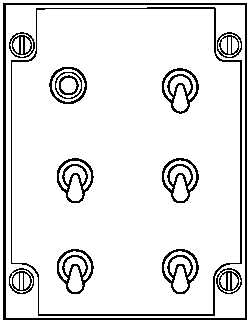TM 1-1520-238-10
2-46
Change 4
b. ASE Control Panel.
The ASE control panel (fig
2-27) located in the pilot left console, has five single-
throw, two-position magnetic switches labeled PITCH,
ROLL, YAW, and ATTD/HOVER HOLD and a BUCS
TEST (BUCS TST) switch.
The BUCS TST switch on the ASE control panel per-
mits the pilot to perform a go no-go check of the BUCS.
The NOE/APRCH switch is part of the stabilator system.
The ASE release button at the base of each cyclic stick
grip, when pressed, causes the three channel switches
and the ATTD/HOVER HOLD switch to drop to OFF. The
ASE control panel receives 28 vdc from the No. 3 essen-
tial dc bus through the ASE DC circuit breaker on the pilot
overhead circuit breaker panel.
M01-290
ASE
YAW
BUCS TST
PLT
CPG
OFF
ROLL
NOE/APRCH
ATTD/HOVER
HOLD
PITCH
OFF
OFF
OFF
OFF
Figure 2-27.
ASE Control Panel
c. Automatic Stabilization.
The DASE has a sta-
bility augmentation system (SAS) and a command aug-
mentation system (CAS). The SAS reduces pilot workload
by dampening airframe movement caused by external
forces such as in air turbulence and weapons recoil. The
CAS augments helicopter response by mechanical con-
trol inputs and commands to the longitudinal (pitch), later-
al (roll), and directional (yaw) flight control servoactuators.
CAS signals are generated by movement of crew station
flight controls which are sent to the DASE computer. The
DASE computer sums the SAS/CAS information with in-
puts from the heading and attitude reference set (HARS)
and the air data sensor system (ADSS). The DASE
computer provides positioning commands to a two-
stage electrohydraulic SAS servo valve on the primary
side of the longitudinal, lateral, and directional flight con-
trol servoactuators. The position of the SAS servo valve
determines the amount and direction of movement of the
SAS actuators. The position of each of the SAS actuators
is transmitted to the DASE computer by the LVDTs. The
motion of each SAS actuator is summed with the mechan-
ical input to each flight control servo, but the SAS actuator
authority is limited to 10% bidirectional motion in all axes
except the longitudinal where the authority is 10% aft and
20% forward. The DASE is engaged through the pilot ASE
control panel.
d. Attitude/Hover Hold.
The hover augmentation
system (HAS) or HOVER HOLD mode of the DASE uses
SAS actuators to maintain position and damp external dis-
turbances to the helicopter. HAS is set by engaging the
ATTD/HOVER HOLD switch or by using the momentary
OFF (up) position of the pilot FORCE TRIM REL switch.
HAS provides the pilot with limited station-keeping or ve-
locity-hold during hover or low speed flight. Position-hold
accuracy is a function of inertial velocity drift errors of the
HARS which can vary with time. The SAS authority mar-
gin will be biased from its center position as these errors
build with time. The attitude hold is a limited authority
mode of the DASE in pitch and roll axes. This mode pro-
vides the pilot with limited hands-off flight capabilities in
cruise flight. Attitude hold will only function if: (1) the
ATTD/HOVER HOLD, PITCH, and ROLL switches on the
ASE panel are engaged; (2) force trim is on, and (3) longi-
tudinal airspeed of the helicopter is greater than 60 KTAS.
CAS is removed when the attitude hold mode is engaged.
CAUTION
HAS should not be used as the sole
method for station keeping. Cross-
checking obstacle clearance using visu-
al or NVS means shall be accomplished.
Do not activate HAS on the ground or
land with HAS on. Uncommanded air-
craft attitude changes may result.
The initialization and stability of the HAS is affected by the
HARS velocity drift. A HARS velocity error at HAS initiali-
zation will cause initial aircraft movement (at a rate pro-
portional to the HARS velocity error) that may be trimmed
using the cyclic force trim. Subsequent changes in the
HARS velocity accuracy, during prolonged engagement of
the HAS, will cause additional aircraft movement that may
be re–trimmed.

